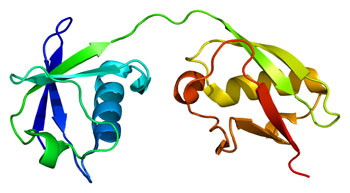Lack of Gene that Protects Mice Promotes Anti-Viral Immunity in Humans
By LabMedica International staff writers
Posted on 08 Jun 2016
Researchers have resolved the question of why a gene that plays an important role in protecting mice from viral infection does not have a similar role in humans.Posted on 08 Jun 2016
The interferon-stimulated gene 15 (ISG15) codes for a secreted protein (Isg15) whose main cellular function is ISGylation, which is the covalent addition of the protein to cytoplasmic and nuclear proteins - a process similar to ubiquitination.

Image: The structure of the Isg15 protein (Photo courtesy of Wikimedia Commons).
Isg15 exists intracellularly and extracellularly as a free molecule and as the form conjugated to target proteins. Studies in mice have demonstrated a role for Isg15 in antiviral immunity. By contrast, human Isg15 was shown to have critical immune functions, but not in antiviral immunity. Namely, free extracellular Isg15 was crucial in IFN (interferon)-gamma-dependent antimycobacterial immunity, while free intracellular Isg15 was crucial for USP18 (Ubiquitin specific peptidase 18)-mediated downregulation of IFN-alpha/beta signaling. USP18 is a member of the deubiquitinating protease family of enzymes. It is thought to remove Isg15 adducts from a broad range of protein substrates, a process known as deISGylation.
Investigators at the Icahn School of Medicine at Mount Sinai (New York, NY, USA), in a paper published in the May 19, 2016, online edition of the journal Nature Communications, described Isg15-deficient patients who displayed no enhanced susceptibility to viruses in vivo, in stark contrast to Isg15-deficient mice. Furthermore, fibroblasts derived from Isg15-deficient patients displayed enhanced antiviral protection, while expression of Isg15 weakened viral resistance. The investigators attributed the difference between mice and humans to the requirement of Isg15 to sustain USP18 levels in humans, a mechanism not operating in mice.
“To our pleasant surprise, what does not work in mice works beautifully in humans. If you, as a human, do not have that gene, you may be more able to fight off viral infections than others,” said senior author Dr. Dusan Bogunovic, assistant professor of microbiology and pediatrics at the Icahn School of Medicine at Mount Sinai. "Additionally, if you do get infected, you control it better. You are basically like a vaccine in yourself. You do not necessarily experience the same range and degree of symptoms, but you still develop antibodies and T-cells and everything you need to be ready for the next infection.”
“We believe a drug that turns off Isg15 in humans for a brief amount of time would help many people facing an emerging viral infection - but of course, all this needs to be tested,” said Dr. Bogunovic. “The idea is to develop a pill that people can use to protect against pandemics - or even to help an individual stop an emerging cold sore.”
Related Links:
Icahn School of Medicine at Mount Sinai







 Analyzer.jpg)






